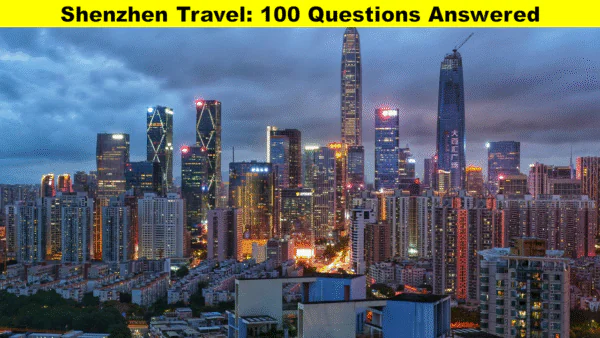Shenzhen Travel: 100 Questions Answered based on NeemTime research
Logistics and Preparation
1. Do I need a visa for Shenzhen? This depends on your nationality. Many countries, including those in the EU and North America, need a visa for mainland China. However, some nationalities can get a Visa on Arrival for a special economic zone like Shenzhen, often for a 5-day stay. Always check the latest visa requirements for your country with the Chinese embassy or consulate before you travel.
2. Is it better to fly into Shenzhen or Hong Kong? Flying into Hong Kong International Airport (HKG) is often a popular choice for travelers to Shenzhen. The two cities are well-connected by MTR (Hong Kong’s metro system) and cross-border buses. Traveling from HKG to Shenzhen is relatively easy and straightforward.
3. What’s the best way to get from Hong Kong to Shenzhen? The most common methods are:
MTR: Take the MTR to the Lo Wu or Futian checkpoints. This is efficient and a popular option.
Cross-border buses: These are a convenient way to travel directly between many parts of Hong Kong and Shenzhen.
High-speed rail: A very fast option from Hong Kong’s West Kowloon Station to Futian or Shenzhen North.
4. What essential apps do I need in Shenzhen? The most crucial apps are:
WeChat (Weixin): The all-in-one app for messaging, payments (Weixin Pay), and accessing various “mini-programs” for services like food delivery, ticket booking, and more.
Alipay: Another widely used digital payment app. Having both is a good backup.
Didi: The Chinese equivalent of Uber for ride-hailing.
Baidu Maps (or Gaode Maps/Amap): These are the most accurate and reliable navigation apps in China, as Google Maps can be inaccurate due to government regulations.
Pleco: An offline Chinese dictionary is a lifesaver for translation.
5. How do I use mobile payments as a foreigner? You must link your international credit card to WeChat Pay and/or Alipay. This is a multi-step process that requires identity verification with your passport. It’s highly recommended to do this before you arrive in China, as it can be difficult to set up on the spot.
6. Do I need cash in Shenzhen? Cash is rarely used. While major stores may accept it, many smaller vendors and taxis do not have change or prefer not to handle cash. It’s much more convenient to rely on mobile payments.
7. Should I get a VPN? Yes. You will need a VPN to access sites like Google, Facebook, Instagram, YouTube, and many Western news sites. It is essential to download and set it up before you arrive in China. Look for reliable VPNs that are known to work in the country, as many free or less-known services are blocked.
Getting Around
8. Is the public transportation good in Shenzhen? Yes, the metro system is excellent, efficient, and clean. It is the best way to get around the city. You can pay with your phone using a transit app or by purchasing a ticket with cash.
9. Can I use my phone’s data or do I need a SIM card? Your best options are:
International Roaming: Many carriers offer international plans that bypass China’s internet restrictions. This is often the most convenient but can be expensive.
Local SIM card: You can buy a local SIM card, but you’ll need to register your passport. Be aware that Chinese SIM cards are subject to the “Great Firewall,” so you’ll still need a VPN.
Things to See and Do
10. What are the top attractions for tourists? Shenzhen is more of a business and living city than a traditional tourist destination, but it has plenty to offer:
Window of the World: A theme park with miniature replicas of famous global landmarks.
OCT Harbour: A lively area with a beautiful lake, restaurants, and a water show.
Dafen Oil Painting Village: A unique village where thousands of artists create and sell reproductions of famous paintings.
Huaqiangbei Electronics Market: A world-famous market for all things electronics. A must-see for tech enthusiasts.
Shenzhen Museum: A great place to learn about the city’s incredible history and rapid development.
11. Where are the best places for shopping?
Luohu Commercial City (near the border): A massive indoor market known for bargaining and a wide variety of goods, including clothing, bags, and electronics.
Dongmen Pedestrian Street: A bustling shopping area with a mix of local shops, food stalls, and a lively atmosphere.
Coco Park: A modern shopping mall with a wide range of international and local brands, as well as a popular nightlife scene.
12. Is the food in Shenzhen good? Yes. As a city of immigrants, Shenzhen has a very diverse culinary scene. You can find authentic regional Chinese cuisines from all over the country, as well as international food. Look up restaurants on apps like Dianping to find good options.
13. What is there to do at night?
Shekou: This area has a vibrant bar and restaurant scene, popular with expats.
Coco Park: The area around this mall has many bars, clubs, and late-night restaurants.
24-hour spas: A unique and popular experience in Shenzhen, offering massages and various wellness services.
Safety and Culture
14. Is Shenzhen a safe city? Shenzhen is considered one of the safest cities in the world due to its extensive surveillance network and low crime rate. However, it’s always wise to be aware of your surroundings, especially in crowded tourist areas.
15. Do people speak English? In general, English proficiency is limited, especially outside of major hotels and tourist areas. Having a translation app and using mobile payments will make your trip much smoother.
16. Are the beaches in Shenzhen good? Shenzhen’s beaches are not the city’s main attraction. They can be crowded and may not be as pristine as beaches in other parts of the world. However, Dameisha and Xiaomeisha beaches are popular spots for a day trip.
